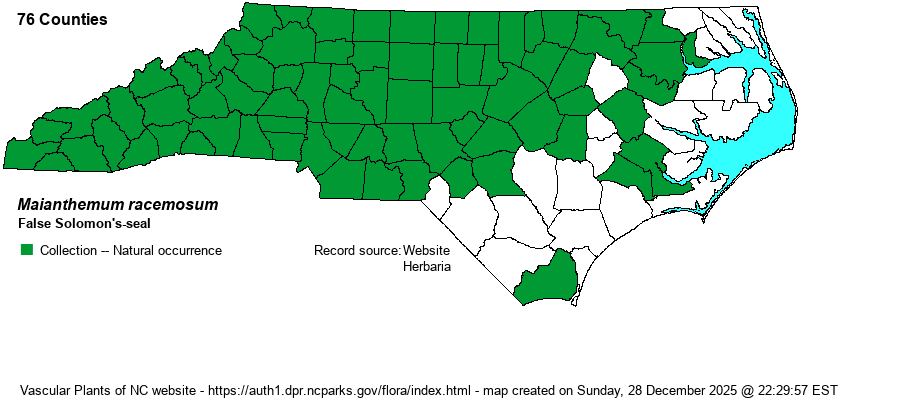| Section 5 » Order Liliales » Family Ruscaceae |
Show/Hide Synonym
| taxonName | relationship | relatedTaxonName | relatedTaxonRefText | relComments |
|---|
| Maianthemum racemosum | = | Maianthemum racemosum ssp. racemosum | Flora of North America (1993b, 1997, 2000, 2002a, 2002b, 2003a, 2004b, 2005, 2006a, 2006b, 2006c, 2007a, 2009, 2010) | | | Maianthemum racemosum | = | Maianthemum racemosum ssp. racemosum | Kartesz (1999) | | | Maianthemum racemosum | = | Maianthemum racemosum ssp. racemosum | Flora of Virginia | | | Maianthemum racemosum | = | Maianthemum racemosum ssp. racemosum | Conran & Tamura in Kubitzki (1998a). | | | Maianthemum racemosum | = | Maianthemum racemosum ssp. racemosum | Conran & Tamura in Kubitzki (1998a). | | | Maianthemum racemosum | < | Smilacina racemosa | Gleason and Cronquist (1991) | | | Maianthemum racemosum | < | Smilacina racemosa | Gleason (1952) | | | Maianthemum racemosum | < | Smilacina racemosa | Radford, Ahles, and Bell (1968) | | | Maianthemum racemosum | < | Smilacina racemosa | Wofford (1989) | | | Maianthemum racemosum | > | Smilacina racemosa var. racemosa | Fernald (1950) | | | Maianthemum racemosum | > | Smilacina racemosa var. racemosa | Flora of West Virginia | | | Maianthemum racemosum | > | Smilacina racemosa var. cylindrata | Fernald (1950) | | | Maianthemum racemosum | > | Smilacina racemosa var. cylindrata | Flora of West Virginia | | | Maianthemum racemosum | > | Vagnera racemosa | Small (1933, 1938) | | | Maianthemum racemosum | > | Vagnera australis | Small (1933, 1938) | | | Maianthemum racemosum | < | Maianthemum racemosum | | | | Maianthemum racemosum | < | Maianthemum racemosum | | | | Maianthemum racemosum | < | Maianthemum racemosum | Wunderlin & Hansen Flora of Florida (3) | | | Source: Weakley's Flora |
|
| Author | (L.) Link | |
| Distribution | Throughout the Mountains and Piedmont, being recorded from all counties; present over the northwestern 50-60% of the Coastal Plain, though scarce to absent in the far eastern and some southern counties, and rare in the Sandhills proper. The Brunswick County record is from a tributary very near the Cape Fear River.
This is an Eastern species occurring from N.S. to Man. south to central GA, the FL Panhandle, and the northeastern corner of TX. | |
| Abundance | Common and quite widespread over the western 75% of the state. Infrequent to locally fairly common in the north-central Coastal Plain, but very rare to absent in the far eastern and southern counties. | |
| Habitat | This is a species of moist to mesic forests, typically on fairly rich hardwood forest slopes, but can be found in many habitats. It occurs in bottomland forests, as well as upland into moderately dry forests, and into mixed forests. |
| Phenology | Blooms from mid-April into June, and fruits from August into October. | |
| Identification | This is a very familiar wildflower that needs little introduction. It has an unbranched and typically arching or leaning stem, to about 1.5 feet long. It has numerous, alternate leaves -- two-ranked (in the same plane), with each leaf being elliptical, entire, and heavily parallel-veined and reaching about 3-4 inches long. At the end of the stem is the dense panicle of small white flowers; the panicle is typically about 4 inches long. The stem is often somewhat zigzag, bending slightly at each leaf node. Even when not in bloom, the heavily veined leaves and slight zigzag stem are conspicuous. It takes little effort to find the species in most parts of the state, as it grows on most mesic to moist hardwood forest slopes. Because it is so common and widespread, it is not normally a target for wildflower enthusiasts on spring walks, despite its attractiveness! | |
| Taxonomic Comments | This species was named as Smilacina racemosa for most of the 20th Century, but it has been moved into the same genus as the quite small Canada Mayflower (M. canadense), a surprise to many people. Weakley (2018) discusses several varieties that have been described for the Southeastern states, as well as a western counterpart species (M. amplexicaule) that is sometimes merged into this one, as can be seen on the BONAP map.
| |
| Other Common Name(s) | Solomon's-plume, Eastern Solomon's-plume, May-plume, Feathery False-lily-of-the-valley | |
| State Rank | S5 | |
| Global Rank | G5 | |
| State Status | | |
| US Status | | |
| USACE-agcp | FACU link |
| USACE-emp | FACU link |

